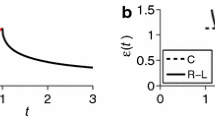Abstract
The fractional viscoelastic equation (FVE), which is a second-order differential equation with fractional derivatives describing the dynamical behavior of a single-degree-of-freedom viscoelastic oscillator, is considered. Some viscoelastic damped mechanical systems may be described by FVEs. However, FVEs with conventional nonzero initial values cannot generally be solved. In this paper, the prehistories of the unknown functions before the initial times, referred to as the initial functions, are taken into account to solve FVEs. Mathematically, appropriate initial functions are essential for unique solutions of FVEs. Physically, the initial functions reflect the processes of giving the initial values. FVEs are solved for some initial functions both by analytical and numerical methods. The initial functions affect the solutions of FVEs. It is discussed how the solutions depend on the initial functions. Implication of the solutions to viscoelastic materials will be discussed.
Similar content being viewed by others
References
Shimizu, N. and Zhang, W., ‘Fractional calculus approach to dynamic problems of viscoelastic materials’, JSMEInternational Journal, Series C42, 1999, 825–871.
Zhang, W. and Shimizu, N., ‘Damping properties of the viscoelastic material described by fractional Kelvin-Voigt model’, JSME International Journal, Series C42, 1999, 1–9.
Bagley, R. and Torvik, P., ‘A theoretical basis for the application of fractional calculus to viscoelasticity’, Journal of Rheology27, 1983, 201.
Bagley, R. and Torvik, P., ‘Fractional calculus – A different approach to the analysis of viscoelasticity damped structures’, AIAA Journal21, 1983, 741.
Bagley, R. and Torvik, P., ‘Fractional calculus inthe transient analysis of viscoelastically damped structures’, AIAA Journal23, 1985, 918.
Bagley, R. and Torvik, P., ‘On the fractional calculus model of viscoelastic behavior’, Journal of Rheology30, 1986, 133.
Ochmann, M. and Makalov, S., ‘Representation of the absorption of nonlinear waves by fractional derivatives’, Journal of American Acoustics Society94, 1993, 3392.
Lorenzo, C. and Hartley, T., ‘Initialization, conceptualization, and application’, NASA/Tp-1998-208415, December 1998.
Lorenzo, C. and Hartley, T., ‘Initialized fractional calculus’, International Journal of Applied Mathematics3, 2000, 249.
Lorenzo, C. and Hartley, T., ‘Initialization in fractionalorder systems’, in Europian Control Conference, Porto, Portugal, September 4–7, 2001.
Fukunaga, M., ‘A difference method for initial value problems of ordinary fractional differential equations’, International Journal of Applied Mathematics8, 2002, 127–147.
Fukunaga, M., ‘A difference method for initial value problems of fractional wave diffusion equations’, International Journal of Applied Mathematics8, 2002, 449–468.
Fukunaga, M., ‘On initial value problems in fractional differential equations’, InternationalJournal of Applied Mathematics9, 2002, 219–236.
Hartley, T. T. and Lorenzo, C., ‘Dynamics and Control of Initialized Fractional-Order Systems’, Nonlinear Dynamics29, 2002, 201.
Fukunaga, M. and Shimizu, N., ‘Initial condition problems of fractional viscoelastic equations’, in ASME DETC 2003, Abstracts DETC 2003/VIB-48394, Chicago, Illinois, September 2–6, 2003, p. 657.
Cossar, J., ‘A theorem on Ces’aro summability’, Journal of London Mathematics Society16, 1941, 56.
Fukunaga, M., ‘On uniqueness of the solutions of initial value problems in fractional differential equations’, International Journal of Applied Mathematics10, 2002, 177–189.
Fukunaga, M., ‘On uniqueness of the solutions of initial value problems of ordinary fractional differential equations, II’, International Journal of Applied Mathematics10, 2002, 269–283.
Jerbashyan, M. and Nersesyan, A., ‘On the application of some integro-differential operators’, Dokl. Acad. Nauk. SSSR121, 1958, 210.
Caputo, M., ‘Linear model of dissipation whose Q is almostfrequency independent – II’, Geophysics Jouurnal of Royal Astrological Society13, 1967, 529–539.
Achar, B. N. N., C. L. and Hartley, T., ‘Initialization and caputo fractional derivative’, NASA/TM-2003-212482, July.
Podlubny, I., Fractional Differential Equations, Academic Press, New York, 1999.
Padovan, J., ‘Computational algorithms for FE formulationsinvolving fractional operators’, Computational Mechanics2, 1987, 271.
Zhang, W. and Shimizu, N., ‘Numerical Algorithmfor Dynamic Problems Involving Fractional Operators’, JSME International Journal, Series C41, 1998, 364–370.
Fukunaga, M., ‘A difference method for initial value problems for ordinary fractional differential equations. II’, InternationalJournal of Applied Mathematics11, 2002, 215–243.
Author information
Authors and Affiliations
Corresponding author
Rights and permissions
About this article
Cite this article
Fukunaga, M., Shimizu, N. Role of Prehistories in the Initial Value Problems of Fractional Viscoelastic Equations. Nonlinear Dyn 38, 207–220 (2004). https://doi.org/10.1007/s11071-004-3756-6
Received:
Accepted:
Issue Date:
DOI: https://doi.org/10.1007/s11071-004-3756-6




